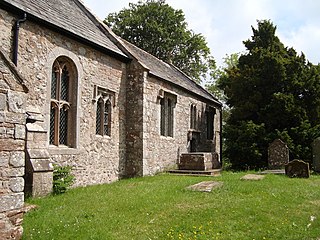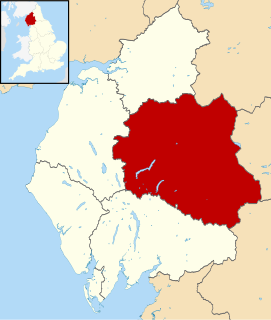Camerton is a civil parish in the Borough of Allerdale in Cumbria, England. It contains three listed buildings that are recorded in the National Heritage List for England. All the listed buildings are designated at Grade II, the lowest of the three grades, which is applied to "buildings of national importance and special interest". The parish contains the village of Camerton and surrounding countryside. The listed buildings comprise a church, a country house, and a farmhouse and barn.
Holme Abbey is a civil parish in the Borough of Allerdale in Cumbria, England. It contains 15 listed buildings that are recorded in the National Heritage List for England. Of these, one is listed at Grade I, the highest of the three grades, one is at Grade II*, the middle grade, and the others are at Grade II, the lowest grade. The parish contains the village of Abbeytown and smaller settlements, and is otherwise rural. The most important building in the parish was Holmcultram Abbey part of which has been converted into a parish church, and other parts have been used in other buildings. Most of the other listed buildings are houses and associated structures, farmhouses and farm buildings.
Setmurthy is a civil parish in the Borough of Allerdale in Cumbria, England. It contains nine listed buildings that are recorded in the National Heritage List for England. Of these, one is listed at Grade II*, the middle of the three grades, and the others are at Grade II, the lowest grade. The parish is almost entirely rural, and the listed buildings consist of a country house and associated structures, farmhouses and farm buildings, a church, and a bridge.
Cumrew is a civil parish in the Carlisle district of Cumbria, England. It contains eleven listed buildings that are recorded in the National Heritage List for England. All the listed buildings are designated at Grade II, the lowest of the three grades, which is applied to "buildings of national importance and special interest". The parish contains the village of Cumrew and is otherwise rural. Its listed buildings consist of houses, farmhouses, farm buildings, and a church.
Orton is a civil parish in the Carlisle district of Cumbria, England. It contains twelve listed buildings that are recorded in the National Heritage List for England. Of these, one is listed at Grade II*, the middle of the three grades, and the others are at Grade II, the lowest grade. The parish contains the village of Great Orton, and the smaller settlements of Little Orton and Baldwinholme, and is otherwise rural. The listed buildings consist of farmhouses, farm buildings, houses and associated structures, a church, and a war memorial in the churchyard.
Stapleton is a civil parish in the Carlisle district of Cumbria, England. It contains seven listed buildings that are recorded in the National Heritage List for England. All the listed buildings are designated at Grade II, the lowest of the three grades, which is applied to "buildings of national importance and special interest". The parish is almost entirely rural, and the listed buildings, apart from a church, are all farmhouses, farm buildings, and associated structures.
Muncaster is a civil parish in the Borough of Copeland, Cumbria, England. It contains 14 buildings that are recorded in the National Heritage List for England. Of these, two are listed at Grade I, the highest of the three grades, one is at Grade II*, the middle grade, and the others are at Grade II, the lowest grade. The parish contains the coastal village of Ravenglass and countryside to the east. The most important building in the parish is Muncaster Castle; this and buildings associated with it, including St Michael's Church and associated structures, are listed. The other listed buildings are houses, farmhouses, farm buildings, and a war memorial.
Asby is a civil parish in the Eden District, Cumbria, England. It contains 22 buildings that are recorded in the National Heritage List for England. Of these, one is listed at Grade I, the highest of the three grades, four are at Grade II*, the middle grade, and the others are at Grade II, the lowest grade. The parish contains the small villages of Great Asby and Little Asby, and is otherwise almost completely rural. Most of the listed buildings are houses and associated structures, farmhouses and farm buildings. The other listed buildings comprise a church, a lych gate, almshouses, a roadbridge, a footbridge, and two wells.
Castle Sowerby is a civil parish in the Eden District, Cumbria, England. It contains 19 buildings that are recorded in the National Heritage List for England. Of these, one is listed at Grade I, the highest of the three grades, two are at Grade II*, the middle grade, and the others are at Grade II, the lowest grade. The parish is almost entirely rural, and most of the listed buildings are houses, farmhouses, and farm buildings scattered around the parish. The other listed buildings are a church and a bridge.
Catterlen is a civil parish in the Eden District, Cumbria, England. It contains seven buildings that are recorded in the National Heritage List for England. Of these, one is listed at Grade I, the highest of the three grades, one is at Grade II*, the middle grade, and the others are at Grade II, the lowest grade. The parish contains the village of Newton Reigny and is otherwise rural. The listed buildings comprise a tower house and associated structures, a church, a house, farmhouses and farm buildings.
Clifton is a civil parish in the Eden District, Cumbria, England. It contains 15 buildings that are recorded in the National Heritage List for England. Of these, one is listed at Grade II*, the middle of the three grades, and the others are at Grade II, the lowest grade. The parish contains the village of Clifton,and is otherwise rural. Most of the listed buildings are houses, farmhouses, and farm buildings. The other listed buildings include a church, a cross in the churchyard, a boundary stone, and a pottery.
Dufton is a civil parish in the Eden District, Cumbria, England. It contains eleven listed buildings that are recorded in the National Heritage List for England. All the listed buildings are designated at Grade II, the lowest of the three grades, which is applied to "buildings of national importance and special interest". The parish contains the village of Dufton and the surrounding countryside. Most of the listed buildings are houses and associated structures, farmhouses and farm buildings in the village centre. Also in the village is a listed pump. Away from the centre of the village, and listed, are a church, its rectory and structures in the rectory garden.
Little Strickland is a civil parish in the Eden District, Cumbria, England. It contains eleven listed buildings that are recorded in the National Heritage List for England. Of these, one is listed at Grade II*, the middle of the three grades, and the others are at Grade II, the lowest grade. The parish contains the village of Little Strickland and the surrounding countryside. The listed buildings comprise houses, farmhouses, farm buildings, and a church and associated structures.
Morland is a civil parish in the Eden District, Cumbria, England. It contains 13 listed buildings that are recorded in the National Heritage List for England. Of these, one is listed at Grade I, the highest of the three grades, one is at Grade II*, the middle grade, and the others are at Grade II, the lowest grade. The parish contains the village of Morland and the surrounding countryside. Most of the listed buildings are in the village, and they consist of houses and associated structures, farmhouses and farm buildings, and a church and associated structures. Outside the village the listed buildings are a house, a barn, and a bridge.
Murton is a civil parish in the Eden District, Cumbria, England. It contains eleven listed buildings that are recorded in the National Heritage List for England. Of these, two are listed at Grade II*, the middle of the three grades, and the others are at Grade II, the lowest grade. The parish contains the villages of Murton and Hilton and the hamlet of Brackenber, and is otherwise rural. Most of the listed buildings are houses and associated structures, farmhouses and farm buildings, the other buildings consisting of two village pumps, a bridge, and a disused railway viaduct.
Newbiggin is a civil parish in the Eden District, Cumbria, England. It contains 14 listed buildings that are recorded in the National Heritage List for England. Of these, one is listed at Grade II*, the middle of the three grades, and the others are at Grade II, the lowest grade. The parish includes the village of Newbiggin and the surrounding countryside. The most important building is Newbiggin Hall, originally a tower house and later a country house; the hall and associated structures are listed. The other listed buildings Include a church, items in the churchyard, a chapel, a bridge, farmhouses and farm buildings.
Newby is a civil parish in the Eden District, Cumbria, England. It contains 14 listed buildings that are recorded in the National Heritage List for England. Of these, two are listed at Grade II*, the middle of the three grades, and the others are at Grade II, the lowest grade. The parish includes the village of Newby and the surrounding countryside. Most of the listed buildings are houses and associated structures, farmhouses and farm buildings, the other listing buildings consisting of the walls and memorials of a Friends' burial ground.
Orton is a civil parish in the Eden District, Cumbria, England. It contains 15 listed buildings that are recorded in the National Heritage List for England. Of these, two are listed at Grade II*, the middle of the three grades, and the others are at Grade II, the lowest grade. The parish contains the village of Orton, and smaller settlements including Kelleth, Raisbeck, and Greenholme, but is almost completely rural. Most of the listed buildings are houses and associated structures, farmhouses and farm buildings. The other listed buildings are a church, a packhorse bridge, a marker stone, and two former schools.
Ousby is a civil parish in the Eden District, Cumbria, England. It contains 15 listed buildings that are recorded in the National Heritage List for England. All the listed buildings are designated at Grade II, the lowest of the three grades, which is applied to "buildings of national importance and special interest". The parish includes the villages of Ousby and Melmerby, together with the surrounding countryside, and hills and fells to the east. The listed buildings consist of two churches, two medieval cross bases, houses, farmhouses and farm buildings, a former post office, an inn, and a former shepherd's hut, later used as a walkers' hut.
Skelton is a civil parish in the Eden District, Cumbria, England. It contains 56 listed buildings that are recorded in the National Heritage List for England. Of these, three are listed at Grade I, the highest of the three grades, three are at Grade II*, the middle grade, and the others are at Grade II, the lowest grade. The parish is mainly rural, and contains a number of villages and smaller settlements, including Skelton, Ellonby, Lamonby, Unthank, Unthank End, Laithes, and Ivegill. Most of the listed buildings are country houses and smaller houses with associated structures, farmhouses and farm buildings. The other listed buildings include churches and structures in the churchyards, a chapel, a bridge, a boundary stone, and a war memorial lych gate.







